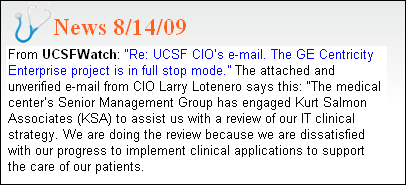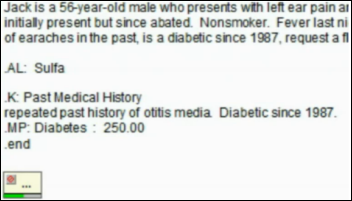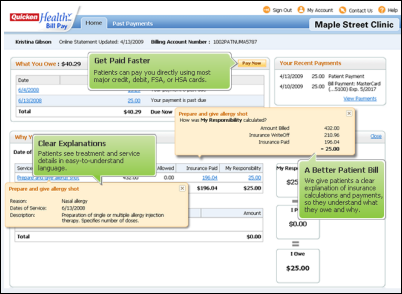Giving a patient medications in the ER, having them pop positive on a test, and then withholding further medications because…
News 10/14/09
From Lizzie Borden: “Re: University of Rochester. I hear they just signed with Epic systems for their EMR solution. What are they installing and are they hiring? Interestingly, I also know that Buffalo Medical Group has acted proactively and offered their Epic analysts a $$ incentive to stay with them instead of fleeing to U of R.” URMC’s Web site says Epic says contract negotiations “were finalized in September 2009.” It also says that they’ve had to scale the $49 million project back, but still hope to nab $8 million of taxpayer ARRA money. It’s the full-blown inpatient system, apparently, expected to go live in the fall of 2011. Details here.
From Topper Harley: “Re: trial. Not too nice of the doctor!” An HIT company executive goes on trial this week, facing multiple felony charges for an alleged road rage incident. I initially did a detailed write-up complete with links and accident scene photos, but I reconsidered for several reasons: (a) he’s been charged, but not found guilty, which means he’s innocent; (b) he is an HIStalk reader and I’ve swapped e-mails with him in the past, so it would be needlessly painful for him to read the story here and know that his peers are doing the same; (c) I could easily wreck his career unintentionally just by giving the unproven details a spotlight. If and when he’s found guilty of something major, I’ll provide details. Until then, I’ll express non-specific sympathy for all involved and my hope that justice prevails.
From Luke O’Scyte: “Re: Ontario. It is called a learning opportunity, or perhaps a teachable moment, how not to spend one billion dollars. The Ontario government, through arrogance and folly, decided that they new best how to pick the market winners, run their own networks, decide on which technologies to approve and which to ignore. So how did that work out for them? See the auditor’s report (warning: PDF).” It’s full of juicy details, like that eHealth Ontario’s CEO paid a recruiter $1 million upfront to fill 15 management positions; one successful contractor’s bid was five times more than a comparable one and more than quadruple the budgeted amount; and $800 million of the $1 billion spent to date was for a private network that “remains significantly underutilized because as yet there is insufficient health-related information on it.” in other words, they jumped all over their equivalent of NHIN without first getting provider EMRs up and running to populate it.
UCSF finally confirms what I reported in August as a rumor (supported by a reader-forwarded copy of an internal department e-mail): UCSF has halted (temporarily, at least) its $50 million GE Centricity project. You’d never know there was trouble in paradise if you Google UCSF+Centricity: the rags and press releases were making it sound like a match made in heaven. Thanks to SF Business Times Chris Rauber for giving HIStalk and rumor reporter UCSFWatch credit.
Here’s the next gossipy tidbit provided to me by one of those UCSF rumor reporters: as soon as UCSF’s lawyers get them out of their GE contract, they’re going with Epic. Unverified.
Cisco takes its Vision Van (or whatever you call a demo trailer) to Auburn Memorial Hospital (NY), showing off technologies such as videoconferencing and mobile caregiver communication.
Eclipsys announces scheduled events for its EUN conference in Dallas next week. ARRA’s on the list, not too shockingly, along with the customer knowledge sharing tool Eclipsys Outcomes Toolkits and physician sessions on its PeakPractice ambulatory EHR.
Welcome back to HIStalk Gold Sponsor MedMatica Consulting Associates of Chester Springs, PA, a software and technology implementation firm (Epic, Eclipsys, Siemens, Meditech, Cerner, etc.) The company provides HISAssist support plans (live, telephone-based, or Web-based) for those vendor products as well. I’m blessed with amazing sponsor retention, so having MedMatica come back soothes my overwhelming feelings of inadequacy at least temporarily.
McKesson announces that all of its physician EMRs can now use Bright Note Technology. I didn’t really understand from the press release what it does, exactly, but it’s some kind of multiple input/single search capability for patient data. I found this demo on YouTube, showing a doctor using speech recognition to dictate a single SOAP note that parses out the information into specific chart data elements.
Inga’s update from MGMA today is on HIStalk Practice.
GetWellNetwork announces GetWell Town, an interactive patient care system designed for pediatric patients, and its first customer, Walt Disney Pavilion at Florida Hospital for Children. It includes care content, child life programming, entertainment options, parental controls, pediatric education, and pediatric pathways.
A summer intern (Harvard-graduated lawyer, Stanford PhD candidate) at IBM Research comes up with an encryption breakthrough that may have great potential for protecting health information, especially with cloud computing. Homomorphic encryption, formerly viewed as impossible by cryptographers because it takes a lot of computing horsepower, allows running calculations on encrypted data without actually decrypting it. IBM hired him, of course.
Listening: My Dying Bride, an old favorite doom metal band that I’d forgotten about.
Weird News Andy characterizes this story as both weird and sad. An 31-year-old English veteran of the war in Iraq dies after receiving cancerous lungs transplanted from a donor who had been a heavy smoker. The tumor wasn’t discovered until months after the transplant, during which time its growth accelerated, fueled by the routine post-transplant immunosuppressive drugs the patient was taking. The delay in noticing the tumor was blamed on poor communication among the radiologists and doctors involved. The cancerous lung made him ineligible for a second transplant since, under hospital rules, he had become a cancer patient.
NIH gives Kaiser $54 million of ARRA/taxpayer money to conduct biomedical and personalized health research using HealthConnect.
RelayHealth announces that 50 health systems and hospitals have contracted to join its RelayHealth Network, which connects 20,000 doctors, 90% of retail pharmacies, and 52 reference labs, all of which automatically update 7.6 million shareable personal health records for HIE connectivity and care coordination. We may need to talk to a participating site since that sounds pretty interesting.
Allscripts announces that it’s the first EMR vendor to integrate its systems with Intuit’s Quicken Health Bill Pay, which gives patients an easily understood statement and the ability to pay online. Doctors get paid 18 days faster on average. Everybody seems to like the Quicken app, which I first wrote about in early 2006 and talked up as potentially a big deal, although it seemed to take a long time to see the light of day.
Also announced: Allscripts will offer its practice customers point-of-care patient payments via mPay Gateway, which calculates patient responsibility and obtains payment authorization before the patient leaves the office. Inga interviewed mPay Gateway CEO Brian Beutner just last week on HIStalk Practice. We asked him the obvious question – are patients really willing to pay before leaving the office? He says 90% of them will. “They like the fact that there are no more unpleasant surprises and the simplicity of taking care of the payment up front, rather than having to wade through numerous statements from the doctor and comparing them to the multiple EOBs and other confusing insurance documents.”
Check out TPD’s list of iPhone applications for healthcare. If you know of others, leave a comment on that article and he will expand his list. Thanks to TPD for putting the list together and for his ongoing contributions to HIStalk.
Dave Roberts, the VP of government relations for HIMSS and former mayor of Solana Beach, CA is running for Congress.
A reader e-mailed to ask if I’d heard of QlikView, with which she was impressed in using it on a consulting project. I hadn’t, so I Googled. It’s a very cool BI tool (check the online demos) and supposedly the fastest growing BI company in the world (which probably means Oracle, IBM, or Microsoft will be buying them next week, unfortunately). I noticed that Bassett Healthcare was listed as one of its healthcare customers, so I Googled yet again to find that apparently Surgical information Systems uses it for its SIS Analytics offering (PDF case study here).
Two Johns Hopkins pediatricians and informatics faculty members launch Applied Clinical Informatics, an official online publication of the International Medical Informatics Association and AMDIS that hopes to “bridge the gap between visionary design and successful and pragmatic deployment.”
The VA awards a claims processing contract worth up to $60 million to VistA integrator Document Storage Systems.
Cedars-Sinai admits that it overdosed 206 CT scan patients with eight times the intended dose of radiation because of “a misunderstanding about an embedded default setting applied by the machine.”
Dell, fresh off its Perot buy, will be looking for more healthcare acquisitions, says Michael Dell.
UVA Medical Center confirms that it will implement Epic, which I speculated in February (I’m not psychic – if a hospital has more than 400 beds, I always guess Epic and I’m usually right). UVA was the hospital that got a lot of press (some of it snarky) recently when it said it would hire scribes instead of repurposing busy doctors, so now we know which EMR they’ll be typing into.
University of Central Florida gets preliminary HHS approval to start a health technology regional extension center and apply for $8 million in stimulus money.
An Oklahoma hospice owner fears that reimbursement cuts and government-encouraged EMRs will drive him out of business. “One of the things they talk about is electronic medical records, which has great applications for medical doctors’ offices, but for hospices, that doesn’t help us at all.”
Philips posts surprisingly good Q3 numbers, with an expected loss of $66 million actually turning into a $258 million profit. Healthcare margins dropped to 9.6% and sales were down 4%, however.
You would think PHR vendor MyMedicalRecords is a huge enterprise given endless press releases and PR efforts. Not so: the quarterly revenue of its money-losing parent company was $221K.
Virginia Tech gets a $28 million NIH grant for infectious disease research at its Virginia Bioinformatics Institute.












Mr. Histalk,
You are such an epic jocksnif.
Why are you always promoting Epic, some small private little company in wisconsin that has “great culture?” They dont have the vision & resources to take Healthcare IT to the next step.
Companies like GE & Siemens are going transform this industry – Epic is simply basting in their glory but doing nothing to innovate. Their days are numbered.
-Yours, Informed.
Mr. HIStalk and Inga,
Superb coverage.
You are right on the hot items.
The clinicians at UCSF are to be commended for putting a stop to the disruptive deployment of the HIT equipment.
I commend the FDA for investigating and then issuing a rads alert after 206 patients were singed by excess ct scan energy. The FDA should do the same for HIT products that have been responsible for injuring orders of magnitude more patients, albeit insidiously. One reason these adverse events are not publicized is because of threats and actions of sham peer review from financially conflicted hospital administrators and their HIT “champions”.
Corpuscle, the Cedars-Sinai story doesn’t really help your cause. In order to overdoes those patients “the hospital had to bypass the protocol that came installed on the machine.” It was user error.
I commend you on holding back on the details of the doctor. That shows alot of thought on your part. I guess that is why I keep coming back here.
QlikView is, indeed a very powerful tool. There are several vendors that have incorporated this BI tool into their offering for surgery management solutions, including Unibased Systems Architecture (USA) in their ForSite Analytics offering and SIS, previously mentioned in your comments. It was rumored at the recent MTORS show that another vendor had chosen their solution as well.
The product is advertised as working the way you think, enabling the user to ask “what about” type of questions by digging deeper into the source data or limiting the scope of the data presented and having the software immediately redrawing the graphs or other KPIs.
Their business model is interesting in that they derive income both from direct sales and from a portion of the sales of their partners’ products, thus setting up an “everybody wins when we grow the business” situation.
Kudos to the SF Business Times:”…the IT project’s woes, which were said to be creating considerable frustration within UCSF Medical Center,…”
Is it true that not one patient suffered during the years of frustration at UCSF?
Those nurses and clinicians inside the institution who were suffering with their patients will assist patients throughout the US by reporting the adverse events to the FDA.
GE and Siemens transforming the industry while “small private little” Epic sits around and fails to innovate.
An interesting perspective from a parallel universe, Informed. Regardless of how anyone feels about GE, Siemens, and Epic, the last 10 years of HIT history tell more or less the opposite story.
(BTW, I didn’t realize it was possible to baste in glory. I’ll have to try that at Thanksgiving. Sounds tasty. Thanks for the tip.)
GE, Siemens, Epic….blah blah blah…the technology is really a commodity.
What Epic has figured out is that executive leadership and process redesign is the what makes these endeavors successful.
Epic does not have the coolest widget…just a sound process.
Sans…you mean basking not basting right…?
Programmer the Omniscient writes:
“Corpuscle, the Cedars-Sinai story doesn’t really help your cause. In order to overdoes those patients “the hospital had to bypass the protocol that came installed on the machine.” It was user error.”
In fact, Programmer, medical errors are usually caused by systemic factors. In this case, the errors likely involve a carelessly designed CT scanner user interface, lack of appropriate periodic testing of the machine as is generally the rule for x-ray equipment that requires periodic calibration and alignment using test objects, poor training of techs, and careless techs and radiologists not noticing that images were overexposed, needing compensation via the grayscale and other image manipulation controls.
Ever try that ol’ Nikon film camera at f2.0 & 1/2 sec on a bright sunny day?
I just wonder if subtle features were missed due to the CT overexposures.
Programmer the Omniscient
I never claimed to be omniscient, all I did was read some articles about the incident, and they did not support the claims of “faulty HIT”. The articles I read indicated that it was due to user error. If you have articles that say it was due to a poor interface, I’d like to see them.
Ever try that ol’ Nikon film camera at f2.0 & 1/2 sec on a bright sunny day?
Yes. I have never blamed the camera when that happens.
Sans…you have got to be kidding me here. Siemens and GE? I assume that was clearly sarcastic. You couldn’t have chosen two more backwards and far behind HIT vendors then Siemens and GE. Epic doesn’t have a superior product, but a better attack strategy to the account (physician based from their days as an ambulatory only product). They still have yet to fully sustain & support their full inpatient system in a multitude of hospitals. Not too mention their inability to play well with others is going to hurt them severely in the long run with interoperability being mandated by the government. In the end, I wouldn’t be the least surprised when Epic turns out to be just like every other software vendor on the planet…just right now we are all seeing them in their honeymoon phase. We all remember Cerner in the late 90s…
Epic wins not because it is the best product. It has MANY MANY holes.
They win because the competition has shot itself in the foot so many times they have no toes left to hang on with…and I might add the HIS world has a ‘lemming follow the trend’ mentality.
It’s what made Cerner in the 90’s, HBO in the 80’s and Siemens (SMS) in the 70’s.